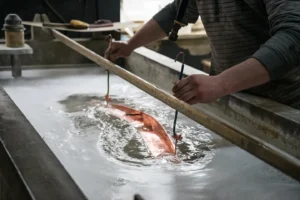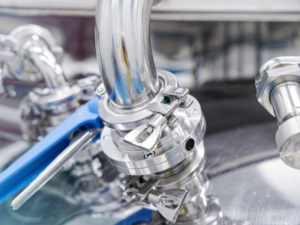At AMF Technologies, we understand the importance of using the right materials for the job. When it comes to lightweight, yet robust components, anodized aluminum is a popular selection for a variety of industries. But what exactly is anodized aluminum, and why should you consider it for your next project?
What is Anodized Aluminum?
Anodizing is an electrochemical process that strengthens the naturally occurring oxide layer on aluminum. By immersing the aluminum in a specific acid solution and applying an electric current, the oxide layer thickens, creating a tougher, more corrosion-resistant surface. This layer is integral to the aluminum itself, unlike paint or plating, so it won’t chip, flake, or peel.
Benefits of Anodized Aluminum
There are several advantages to using anodized aluminum:
- Durability and Corrosion Resistance: Anodizing significantly improves resistance to scratches, wear, and corrosion, making it ideal for harsh environments or applications that require frequent cleaning.
- Lightweight: Aluminum is naturally lightweight, and anodizing doesn’t add significant weight, making it a perfect choice for weight-sensitive projects.
- Aesthetics: Anodizing can create a variety of attractive finishes, from a classic silver to vibrant colors. Dyes can be incorporated into the porous oxide layer for a long-lasting colored finish.
- Electrical Insulation: The oxide layer acts as an electrical insulator, making anodized aluminum suitable for some electrical applications.
- Low Maintenance: Anodized aluminum requires minimal maintenance to retain its appearance and functionality.
Why Not Anodize?
While anodizing offers numerous benefits, it may not be the ideal solution for every application. Here are a few things to consider:
- Size Limitations: The size of the aluminum parts may be restricted by the anodizing tanks available.
- Certain Alloys: Not all aluminum alloys anodize well. If a specific high-strength alloy is required, anodizing may not be a viable option.
- Uneven Surfaces: Deep grooves or complex shapes may not receive a uniform anodized coating.
- Performance Considerations: For high-temperature applications, anodizing may not be suitable as the oxide layer can degrade at elevated temperatures.
Commonly Anodized Aluminum Products and Parts
Many everyday items and industrial components benefit from anodizing, including:
- Building materials: window frames, siding panels, and architectural elements.
- Automotive parts: wheels, trim, and engine components.
- Consumer electronics: laptop cases, smartphone exteriors, and appliance parts.
- Aerospace components: aircraft parts and instruments.
- Marine components: boat parts and hardware.
- Industries that Use Anodized Aluminum
At AMF Technologies, we have extensive experience working with anodized aluminum. We can help you determine if anodizing is the right choice for your project and ensure the best possible results.
Additional Considerations
- Color Options: A wide range of colors can be achieved through anodizing, but some colors may require special dyes or processes.
- Abrasion Resistance: Different anodizing techniques can produce a harder oxide layer for increased abrasion resistance.
- Sealing: The anodized layer can be sealed to improve corrosion resistance and dye retention.
- Environmental Benefits: Anodizing is a clean process compared to many other metal finishing techniques. It doesn’t generate harmful fumes or require harsh chemicals.
- Cost: Anodizing is generally an affordable metal finishing option.
- Machinability: Anodizing can be done before or after machining aluminum. However, machining after anodizing may expose uncoated edges. Additionally, it is important to note that Type III anodizing, which creates a thicker and harder oxide layer, can reduce the lifespan of cutting tools and drill bits due to the increased wear on the tools.
- Safety: The anodized aluminum oxide layer is considered safe and non-toxic.
- Performance Considerations: For high-temperature applications, anodizing may not be suitable as the oxide layer can degrade at elevated temperatures.
- Alternatives to Anodizing: If anodizing isn’t ideal for your project, here are some alternative finishing options to consider:
- Powder Coating: Offers a wider range of colors and textures with good durability.
- Painting: A versatile and cost-effective option but may require touch-ups over time.
- Plating: Provides a conductive or decorative finish but can be more expensive than anodizing.
By understanding the properties and benefits of anodized aluminum, you can make informed decisions about the best options for your metal part needs.
Contact AMF Technologies today to discuss your project requirements and explore how anodized aluminum can enhance your products!














